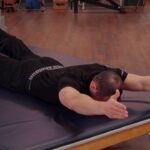Superman Exercise | Prone Extension with Arm & Opposite Leg Lifts
What is the Superman Exercise?
The prone extension with arms and opposite leg lift exercise, also known as the Superman exercise, is a core-strengthening exercise that targets the lower back, glutes, and hamstrings. Here’s how you perform the exercise:
- Lie face down (prone) on a mat or comfortable surface with your legs extended and arms straight out in front of you.
- Engage your core muscles by drawing your navel toward your spine.
- Simultaneously lift your right arm and left leg off the ground while keeping them straight. Keep your gaze down to maintain a neutral neck position.
- Hold the lifted position for a few seconds, focusing on contracting your glutes and engaging your lower back muscles.
- Slowly lower your right arm and left leg back to the starting position.
- Repeat the movement on the opposite side, lifting your left arm and right leg.
- Continue alternating sides for the desired number of repetitions or time.
It’s important to maintain proper form during this exercise. Avoid arching your lower back excessively or lifting your limbs too high, as this can strain your back. Start with a comfortable range of motion and gradually increase it as you build strength and stability.
Early Intervention Benefits of this Prone Extension Exercise
Here are some potential early intervention health benefits associated with this exercise:
- Strengthening the back muscles: The prone extension exercise primarily targets the muscles of the lower back, such as the erector spinae and multifidus. Moreover, regular practice of this exercise can effectively strengthen these muscles, leading to several benefits. Firstly, it can contribute to better posture and spinal stability. Additionally, it may help reduce the risk of lower back pain.
- Improving core stability: While performing the prone extension exercise, you engage the deep core muscles, including the transverse abdominis and the muscles of the pelvic floor. These muscles play a vital role in providing stability and support to the spine. Strengthening the core can enhance overall trunk stability and reduce the risk of injuries.
- Enhancing shoulder stability: The arm lift component of this exercise targets the muscles of the shoulder, including the deltoids, rotator cuff muscles, and scapular stabilizers. Regular practice can help improve shoulder stability, which is important for maintaining proper posture and reducing the risk of shoulder injuries.
- Engaging the gluteal muscles: The opposite leg lift component of the exercise activates the gluteal muscles, including the gluteus maximus, medius, and minimus. These muscles are important for hip stability and proper lower limb mechanics. Strengthening the glutes can contribute to improved posture, reduced risk of hip and knee injuries, enhanced employee workplace performance along with workplace productivity.
- Promoting overall body coordination: The prone extension exercise involves lifting the opposite arm and leg while maintaining stability and control. This movement requires coordination and balance, which can help improve overall body awareness and neuromuscular control.
Things to remember…
It’s important to note that the health benefits may vary from individual to individual. It’s always a good idea to consult with a healthcare professional before starting a new exercise routine. If you have an injury or illness, consult with a health care professional before attempting. They can provide personalized recommendations based on your specific needs and any underlying health conditions. These early intervention exercises are to improve overall health and fitness and help reduce work-related injuries.

